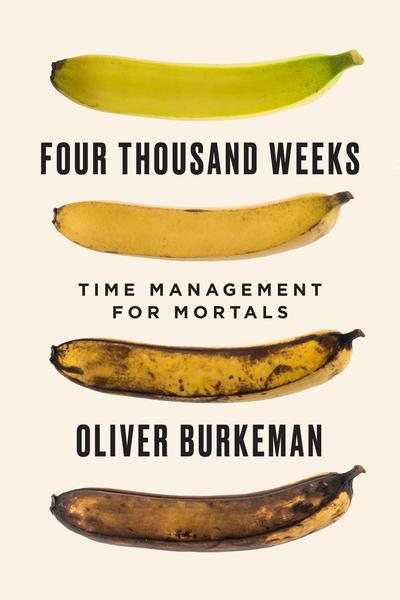
It could have been named 75 years or 900 months or 30 000 days or an even larger number of hours, minutes or seconds. Instead, the unit used was weeks. All of these numbers indicate the approximate human life expectancy.
Four Thousand Weeks: Time Management for Mortals (2021) is Oliver Burkeman’s (1975 – , 2400 weeks) contribution to understanding the temporal limitations of human life. I have come across several reviews of this book, two of which I have read, including one by the author. The others I have either skimmed or ignored.
Burkeman’s own review of his book, At best, we’re on Earth for around 4,000 weeks – so why do we lose so much time to online distraction?, appears in the Guardian 2021-08-07. He begins with a description of 44 wasted minutes, when in 2016-04, two Buzz Feed reporters attach 686 elastic bands to a watermelon, that ultimately explodes. Why do people use their time in such ways? This question applies not only to participants determined to affix elastic bands, but also to the spectators watching the YouTube video, and the commentators reporting on it, including myself, who has not even bothered to watch any of the video. The Watermelon Problem, is also the title of chapter five in the book. The chapter asks, essentially, why do we waste our time on social media, when there is a beautiful real world to experience?
Much of Burkeman’s book consists of name dropping, and the paraphrasing of passages from self-help works. It is divided into two sections. The first, Choosing to Choose, is further divided into six chapters, and looks at how people can act to determine their future. The second, Beyond Control, has eight chapters, and has more about chance.
Burkeman begins his book, by looking at Lewis Mumford (1895 – 1990 = 4919 weeks), Technics and Civilization ( 1934) and a modern concept of time, defined as “an independent world of mathematically measurable sequences.” The industrial revolution was more dependent on the clock, than the steam engine. Burkeman wonders if this attitude toward time sets up a rigged game. One cannot simply live a life unfolding in time. Instead, each moment is judged according to its usefulness in achieving future goals. This will ultimately backfire, because “[I]t wrenches us out of the present, … experiencing everything in terms of some later, hoped-for benefit…” Because of this, deep time, with its vividness of reality, becomes unachievable.
In the second chapter, the Busytown series by Richard Scarry (1919 – 1994 = 3908 weeks) is mentioned. This is because the residents of Busytown, while busy, are not overwhelmed, unlike almost everyone else in modern society. Contemporary life is an extreme version of a law expressed in Parkinson’s Law (1957), “Work expands so as to fill the time available for its completion,” developed by C. Northcote Parkinson (1909 – 1993 = 4362 weeks).
Thus, people are ever engaged in futile activities that reduce labour, and max out convenience. In the words of Burkeman, “Convenience culture seduces us into imagining that we might find room for everything important by eliminating only life’s tedious tasks. But it’s a lie. You have to choose a few things, sacrifice everything else, and deal with the inevitable sense of loss that results.”
Martin Hägglund (1976 – , 2334 weeks) and This Life (2019), his book on secular faith and spiritual freedom, presented in chapter three, Facing Finitude, resonated. Given infinite time, there is no need to prioritize.
Mortals constantly need to choose, or as stated in the fourth chapter, “The good procrastinator accepts the fact that she can’t get everything done, then decides as wisely as possible what tasks to focus on and what to neglect.” This chapter contains three principles. First, if an activity really matters, the only way to be sure it will happen is to do some of it today and no matter how many other activities may be demanding attention. Second, limit the number of works in progress. The third principle is better described than named. Make a list of the top twenty-five things one wants out of life, then arrange them in order, from the most important to the least. Prioritize the top five. Actively avoid the others. They are insufficiently important to be part of a core, but seductive enough to be distracting.
This leads to Robert Goodin (1950 – , = 3690 weeks) and On Settling (2012) involves accepting something that is less than ideal. This can apply to a romantic partner as well as a job, and much more, including: numerous categories of physical objects. Personally and initially, I thought of houses, cars and computing devices. However, it can apply to almost anything, and in a second round, seconds after the first, I thought of sailboats, clothing and tools.
In the second section, life is described as an ever flowing river of time that is always flowing. It is expressed in the the title of chapter seven, We Never Really Have Time. Here, Douglas Hofstadter (1945 – , 3993 weeks) is famous for Hofstadter’s Law: every task will always take longer than you expect, even when Hofstadter’s Law is taken into account. David Cain (1941 – , 4164 weeks) notes that people never have time in the same sense that they have cash in their wallets or shoes on their feet. A claim to having time, is simply an expectation of it.
Hofstadter is an important writer for computer scientists, and others, because of his book Gödel, Escher, Bach: An Eternal Golden Braid (1979). Wikipedia describes it, “By exploring common themes in the lives and works of logician Kurt Gödel [1906 – 1978, 3742 weeks], artist M. C. Escher [1898 – 1972, 3849 weeks] and composer Johann Sebastian Bach [1685 – 1750, 3407 weeks], the book expounds concepts fundamental to mathematics, symmetry, and intelligence. Through short stories, illustrations, and analysis, the book discusses how systems can acquire meaningful context despite being made of “meaningless” elements.”
In Chapter 8, You Are Here, people are told that much of life is preparation for something else. At one point he quotes Alan Watts (1915 – 1973, 3071 weeks) “Take education. What a hoax. As a child, you are sent to nursery school. In nursery school, they say you are getting ready to go on to kindergarten. And then first grade is coming up and second grade and third grade…In high school, they tell you you’re getting ready for college. And in college you’re getting ready to go out into the business world…[People are] like donkeys running after carrots that are hanging in front of their faces from sticks attached to their own collars. They are never here. They never get there. They are never alive.” Eastern Living, Modern Life (2006) p. 109-10.
In terms of a return on investment, there is little point in reading beyond this point. In fact, others may have given up much earlier. Rather than reading, it might be time for everyone to make a plan of what they want to prioritize in this life. This will most often be age dependent. As an older person, I see some neglected interests re-emerging from earlier parts of my life – working with electronics and with sound, for example. Other aspects of it do not hold the same appeal – with boating the best example. In terms of travel, I have an interest in connecting with family and friends, select places in North America and the Nordic countries.
I also see a need for five year plans, where a window of opportunity encourage a focus on a limited range of activities. My personality does not encourage pursuing the same activity throughout a lifetime. I prefer the short or medium-term to the long-term. Currently, I am nearing the end of a phase of concentration on building construction. Initially, it was more rewarding, and I intend to finish off certain aspects of it. However, I am now drawn to other activities. This contrasts with my significant other. Textiles and music were her interests when I first met her. Textiles are still important to her. If a hearing disability had not intervened, I imagine music would have been one of her life-long interests, as well. Unfortunately, that was not to be.
Note: In this weblog post only, the birth and death dates of deceased people are followed with their lifespan measured in weeks. For living persons, their life is given in weeks from their birth to the date of publication of this weblog post, 2021-08-28. Round numbers may indicate that the exact date of birth/ death is unknown. This very situation includes Oliver Burkeman.





